- Offensive Techniques & Strategies
Defending Baseline Out of Bounds Plays
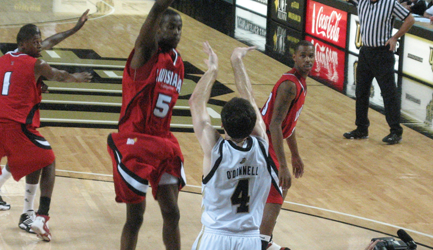
What to Discover or Recall . . .
Realize that most coaches spend little time on ways to defend baseline out of bounds plays.
Recognize that on out of bounds plays, the defense has a numerical advantage.
Comprehend that defending the ball out of bounds on the baseline is totally different than defending the ball when it is out front of the defense.
Explore four effective ways to defend baseline out of bounds plays.If you analyze "Out of Bound" situations, they are unique in that it is the only time during the game of basketball where the defense actually has an advantage. Because of this numerical player advantage (5 on 4), it can be difficult for the offensive team to inbound the ball, and, as a result, numerous NCAA and NBA championships have been lost because teams were not able to make successful inbound passes in the final seconds of game. This is why many coaches like to avoid taking time outs at the end of the game.
Most coaches take it for granted that their basic half court defense applies to baseline out of bounds situations. However, this is not the case. Defending the ball when it is located out of bounds behind the defense is entirely different matter than defending the ball when it is out in front of the defense. In addition, in regular half court set offenses, defenders are mostly guarding shooters moving off screens away from the basket. On baseline out of bounds, the shooters are going directly to the basket. As a result, there is no room for error. If the defense makes an error on an out of bounds play it results in an easy basket.
Some teams will automatically zone on out of bound situations. However, zones are faced with the same problem of having to make adjustments to defend the ball being taken out on the baseline behind the basket rather than out front. In addition, zones are very susceptible to screen and roll action along with overloads, which happens to be the main staple of out of bounds plays.
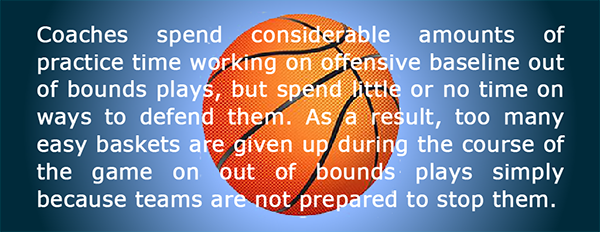
Four Effective Ways to Combat the Baseline Out of Bounds
| Jam | Jump Switch | Trap | Combination Defense |
Coaches should exploit this numerical player advantage to its fullest. Since the vast majority of out of bounds plays revolve around screens, the various techniques used to defend against screens can be incorporated into an effective out of bounds defensive attack.

Smart and alert offensive players will immediately recognize when a defensive player is out of position or has their back turned, and simply cut to the basket receiving a quick pass for an easy lay-up.

1. Disrupt or "Jam" Option
No switching, hard nose "in your face" defense
Although the type of defense employed against baseline out of bounds will vary according to opponent and game situation, total disruption or "Jam" is probably the most effective. When executed, the Jam option not only totally disrupts the baseline out of bounds play, but it can also result in producing five second violations or, better yet, in drawing offensive fouls.
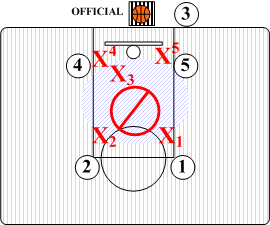
Phase 1. Sag off and protect the middle
Prior to the official handing the ball to the inbounder, players should sag off and protect the basket against any quick lob pass or basket cut. The defender guarding the inbounder should play off (5 on 4) and anticipate the inbounds pass for three seconds.
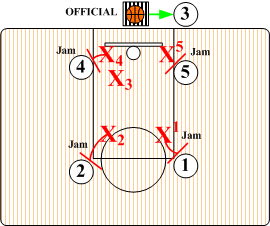
Phase 2. Jam or Smother
Just as the official hands the ball to the inbounder, defenders X1, X2, X4, and X5 step out and aggressively jam their opponents. Do not switch or allow any cuts into the lane, and take an offensive charge. Defender X3 protects the basket for three counts and then rotates back to the inbounder executing an aggressive smother with both hands up.
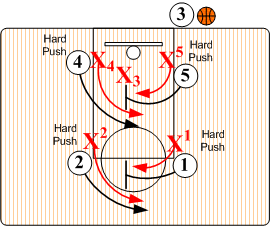
Phase 3. All out denial
X4 and X5 disrupt the screens by forcing screeners O1 and O5 out wide away from the basket. Defenders X2 and X3 also aggressively prevent their opponents from using the screens by assuming aggressive chest to chest, in your face, defensive positions (no switching) forcing O4 and O2 away from the basket.
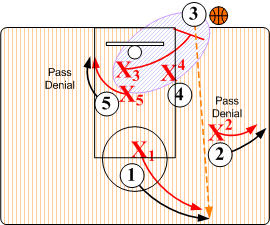
Phase 4. Smothering Inbounder
Defender X3, after third count, releases and aggressively smothers the inbounds passer with both hands up.
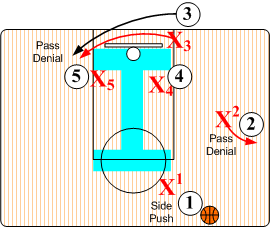
Phase 5A. Matching Up
Once the ball is passed inbounds, basic half court disruptive defensive pressure rules are in effect. X3 assumes a pass denial position and stays with O3. Note: On most inbounds plays, the inbounds passer is a shooter, and after passing the ball inbounds they will normally go off baseline screens for shots.

Phase 5B. Box Pressure
When the ball is passed to the wing, box pressure (5 on 3) is created by X1 denying any return pass to O1 and X2 forcing ball handler O2 toward baseline checkpoint. X4 fronts O4 in low post area and defenders X5 and X3 assume helpside "I" positions.

2. Jump Switch Option
Aggressively jump switching and denying first passing lanes creates turnovers, rushed or bad shots, and often times results in easy transition baskets. Jump switching not only attacks passing lanes, it can also create offensive charges. Jump switching is a very viable option to use when there is less than five seconds remaining on the game or shot clock.
Taking Away the Passing Lanes
Caution: If you are not going to aggressively deny and attack the passing lanes - DO NOT switch.
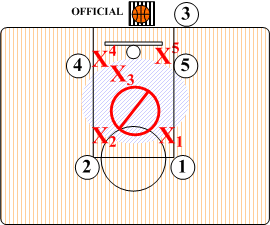
Phase 1. Sag off and protect the middle
Prior to the official handing the ball to the inbounder, players should sag off and protect the basket against any quick lob pass or basket cut. The defender guarding the inbounder should play off (5 on 4) and anticipate the inbounds pass for three seconds.
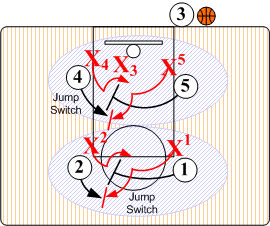
Phase 2. Switch Screens
Defenders X4 & X5 execute an aggressive jump switch on base screen, and X1 &X2 aggressive jump switch the top screen. Upon switching defenders X4 and X2 must immediately step over and deny any roll to the basket by screeners X5 and X1. X1 and X5 switch by jumping out into the path of X4 and X2. X3 sags off protecting the basket area for three counts.
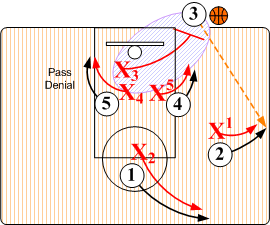
Phase 3. Smothering Inbounder
Defender X3, after third count, releases and aggressively smothers the inbounds passer with both hands up. Once the ball is passed inbounds, basic half court disruptive defensive pressure rules are in effect. X3 assumes a pass denial position and stays with O3. If O3 is a good shooter, X3 should be alert for base screens.
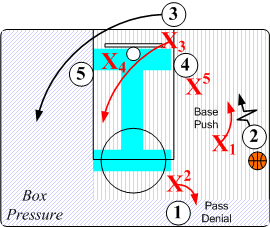
Phase 4. Box Pressure
When the ball is passed to the wing, box pressure (5 on 3) is created by X1 denying any return pass to O1 and X2 forcing ball handler O2 toward baseline checkpoint. X4 fronts O4 in low post area and defenders X5 and X3 assume helpside "I" positions.

3. Trap Option
Aggressively trapping or double teaming on the inbounds pass can effective disrupt any baseline out of bounds play; especially, if the play involves more than one pass. Catching the opponent by surprise, can also lead to a turnover and easy basket.
Double Teaming the Inbounds Pass

Phase 1. Sag off and protect the middle
Prior to the official handing the ball to the inbounder, players should sag off and protect the basket against any quick lob pass or basket cut. The defender guarding the inbounder should play off (5 on 4) and anticipate the inbounds pass for three seconds.
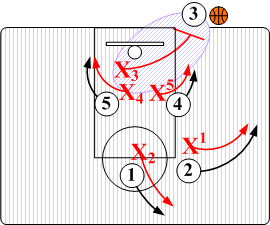
Phase 2. Smothering Inbounder
Defender X3, after third count, releases and aggressively smothers the inbounds passer with both hands up.

Phase 3. Trap or Double Team
When O3 does make an inbounds pass, X3 follows the pass and traps the receiver. X1 and X3 locking up on a hard trap against O2 while X2, X4, and X5 assume triangle helpside positions.
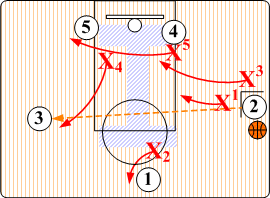
Phase 4. Pass Out of Trap
When O2 passes out of trap, players rotate according to near player rule. X4 closes out to O3 assuming an on ball guarding position, pushing O3 toward corner or baseline checkpoint. X5 rotates across and assumes a post denial position against O5. Defender X2 creates box pressure by denying any reversal pass out to O1. X1 and X3 assumes Helpside I positions.

4. Combination Defense Options
Combination defenses can be used very effectively against baseline out of bounds situation. In deploying a box & one, diamond & one, or a triangle & two defense, it can catch the offense totally off guard resulting in a steal or in forcing the opponent to take a valuable time out.
Combinations defenses are faced with the same problem of having to make adjustments to defend the ball being taken out on the baseline behind the basket rather than out front. After denying the inbounds pass, once the ball is inbounded normal shifts take place.
| Box & One | Diamond & One | Triangle & Two |
Box & One

Phase 1. Sag off and protect the middle
Prior to the official handing the ball to the inbounder, Chaser X3 face guards O1 and defenders X1, X2, X4, and X5 form a defensive box alignment with their hands and arms out stretched.
The defense should be ready and very alert for any quick lob pass or basket cut before the official hands the ball to the inbounder.
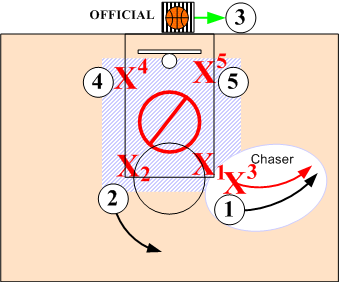
Phase 2. Ball Denial
Chaser X3 assuming an aggressive chest to chest position denies all passes to O1. Defenders X1, X2, X4 and X5 play box zone with their hands and arms stretched out.
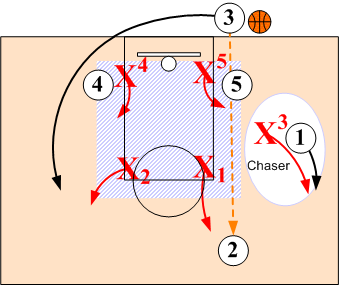
Phase 3. Match Up
Once the ball is inbounded, X1, X2, X4 and X5 assume a box zone. Chaser X3 continues to face guard O1 preventing O1 from receiving the ball. Be sure to box out on shots and do not allow any second efforts.
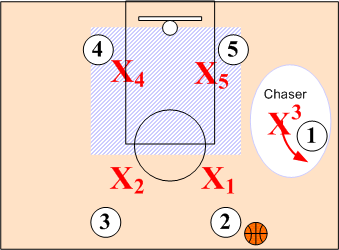
Phase 4A. Box Zone
If the opponents use a two guard front, play "Box & One" defense.
Diamond & One
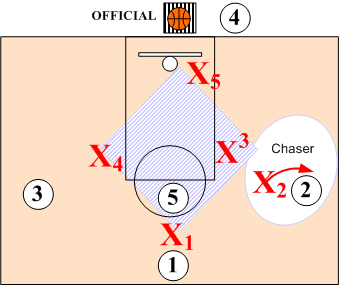
Diamond Zone
Sag off and protect the middle prior to the official handing the ball to the inbounder.
Chaser X2 face guards O2 and defenders X1, X2, X4, and X5 form a diamond alignment with their hands and arms out stretched.
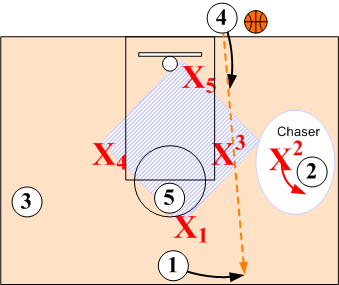
Inbounds Pass
When the opponents use a one guard front alignment, the defense should match up and employ the "Diamond & One" defense.
Triangle & Two Combination Defense
The "Triangle and Two" defense incorporates the same principles of the Box & One, but deploys two defensive chasers. The other three defensive players assume a triangle zone defense with their hands and arms out stretched. The two Chasers play full out aggressive chest to chest, in your face, total pass denial defense against their assigned opponents.
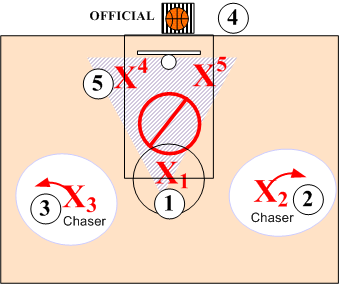
Triangle Zone
Sag off and protect the middle prior to the official handing the ball to the inbounder.
Chasers X2 and X3 face guards O2 and O3. Defenders X1, X4, and X5 form a triangle zone with their hands and arms out stretched.
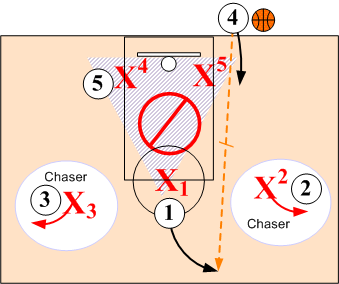
Inbounds Pass
Chasers X2 and X3 maintain their strong pass denials on O2 and O3.
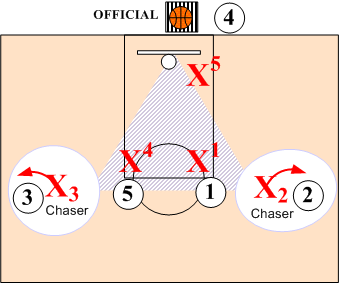
Inverting
When the opponent deploys an offensive alignment with a two guard front, invert the triangle.
Return to Defensive Strategies - Click Here
Return to HoopTactics - Click Here
© 2024 HoopTactics All Rights Reserved.

